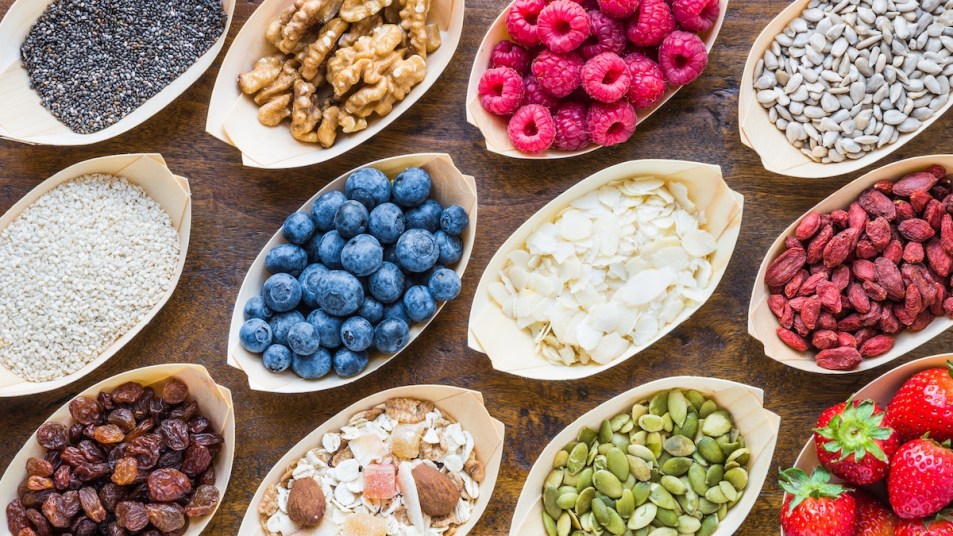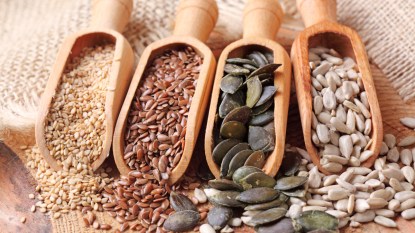What Are Super Foods? (And 7 to Start Eating Regularly if You’re Over 50)
They're delicious, nutritious, and highly versatile.

Superfoods: You’ve likely heard of them and their holy-grail status on the food pyramid. But what exactly are superfoods, and how can you add them to your diet? I’ve tried just about every superfood on the market, from kale to algae and everything in between, and have found that they improve my well-being — both physical and mental — substantially. Keep reading for more info on superfoods, from how they help slow the aging process to the seven you should be eating at least once a week.
What are superfoods?
Avocados, blueberries, quinoa — these foods probably all come to mind when you think of superfoods. But why? What makes a superfood, well, super? This category of food includes a big slice of the food pyramid, with lots of fruits, veggies, and some dairy and fish products making the cut. But all of these foods are linked by a few shared attributes that take them from plain old “good for you” to nutritional powerhouses.
First and foremost, superfoods help boost your immune function and decrease your risk of disease. They’re packed with important vitamins, minerals, and amino acids, as well as antioxidants, heart-healthy fats, omega-3 fatty acids, and fiber, all of which promote heart health, reduce risk of cancer, and lower inflammation and cholesterol. And while no food can completely reverse the aging process, incorporating superfoods into a well-balanced diet is about as close as you can get. Eating nutritionally dense foods like dark leafy greens, whole grains, and berries helps lower the risk of numerous diseases, particularly those whose odds increase as we age. Not all foods (not even all superfoods) are created equal, however. Here are seven superfoods that you should add to your diet right now.
Curious about the Top Superfoods for Diabetes Management? Watch this video.
Dark Leafy Greens for Heart Health
Dark leafy greens, such as kale, Swiss chard, spinach, and collard greens, are excellent sources of important minerals, including zinc, potassium, magnesium, calcium, folate, iron, and vitamin C. They also contain fiber and carotenoids, which have anti-inflammatory effects. All of these nutrients are rock stars when it comes to heart health and the prevention of other chronic diseases, such as type 2 diabetes and certain types of cancer. Leafy greens like kale and chard are often described as bitter, but trust me when I say that when prepared correctly, these essential healthy-eating ingredients can be delicious, especially with the right salad (or sandwich, or smoothie, or grain bowl with sweet potatoes and brown rice…).
There are so many ways to incorporate dark greens into a healthy diet. One of the easiest is tossing kale with olive oil, garlic, and red pepper flakes and then baking it in the oven. (Believe me, you haven’t tasted kale as it was intended until you’ve had it baked!) Regardless of how you do it, make sure to get those dark greens into your diet — they’re one of the best ways to support heart health and reduce risk of disease.
Berries for Antioxidants
Want to protect yourself from the aging impacts of free radicals and inflammation? Start your day with a bowl of berries for breakfast. These healthy foods, including raspberries, blueberries, blackberries, strawberries, and cranberries, are packed with antioxidants (which nutritionists and medical experts consider the secret key to anti-aging). Antioxidants help fight free radicals and reduce risk of developing inflammatory conditions, including cancer and heart disease. In other words, they’re nutritional superheroes.
Berries might be a little easier to incorporate into your diet than leafy greens, but don’t be afraid to get creative when reaping their nutritional value. Add them to salads, incorporate them in desserts, and of course, mix them into your morning oatmeal or smoothie. They’ll fill your belly while fueling your immune system.
Legumes for Losing Weight
Legumes, also known as pulses, are a food group that includes peas, beans, peanuts, and lentils. They’re packed with B vitamins and protein, which is why they’re so helpful for maintaining a healthy weight — these fiber-rich foods keep you full and satisfied long after you’re done eating. Plus, they’ve been shown to lower cholesterol and blood pressure and help manage type 2 diabetes. That’s a lot of benefits for foods that are literally the size of a pea! An easy way to incorporate legumes into your diet is in a hearty minestrone soup. Simply toss leftover veggies, beans, and pasta into a pot, and let them simmer. Your taste buds and your waistband will thank you!
Nuts and Seeds to Protect Against Heart Disease
Good sources of monounsaturated fats and plant protein are nuts and seeds, including:
- Almonds, pistachios, walnuts, pecans, pistachios, Brazil nuts, pinenuts
- Hemp seeds, pumpkin seeds, chia seeds, flaxseeds, sunflower seeds
Nuts and seeds are both calorically dense (read: filling) and packed with important nutritional compounds, including phytochemicals, carotenoids, and antioxidants. These compounds offer protection from oxidative stress and inflammation, both of which accumulate as we age and can lead to chronic disease, including heart disease. A diet rich in a variety of nuts and seeds is one of the best ways to promote heart health.
If you aren’t used to eating nuts and seeds, don’t worry — there are lots of ways to add them to your diet without even noticing. Nuts are a great salad topper and go well with many desserts; seeds can easily be added to muffin recipes — hemp seeds and poppy seeds, for instance, pair well with lemon; and both nuts and seeds make a great addition to yogurt, smoothies, and oatmeal.
Garlic to Support Your Immune System
I can’t count how many of my go-to recipes begin with heating olive oil and garlic in a pan, which makes it super convenient that this sometimes-vegetable sometimes-spice (depending on who you ask) is one of the healthiest foods in the grocery store. Garlic is packed with important vitamins and minerals, including vitamin C, vitamin B6, manganese, selenium, and fiber.
Thanks to these nutrients, consuming garlic is one of the best things you can do to support your immune health and reduce your chance of getting sick. It’s also been shown to reduce blood pressure and cholesterol and even lower the risk of developing cancer. Garlic might be notoriously stinky, but in this case, the bad breath is worth it.
Green Tea: Also Great for Antioxidants (and Weight Loss)
Green tea is a tried and true weight loss amplifier. It’s rich in polyphenols and antioxidants, including catechins, which — in combination with the caffeine in tea — have been shown to promote weight loss in some people. Plus, antioxidants and polyphenols are rich in anti-inflammatory compounds, which can help prevent cancer, diabetes, and other chronic diseases by fighting off free radicals.
If you’re a coffee person, try replacing your second cup of the day with green tea. It will likely help you feel more relaxed — without reducing your focus — and it will deliver a healthy serving of antioxidants, too. By incorporating green tea into your morning routine, you’ll reap the benefits of this super food-turned-drink.
Ginger for Pain and Nausea Relief
Ginger has been used medicinally and in culinary applications for centuries. Although scientists aren’t exactly sure how it works within the body, it’s proven effective at treating acute and chronic pain. It’s likely that gingerol, one of the antioxidants found in ginger, is responsible for the spice’s many benefits. You can find ginger fresh or in the spice aisle at the grocery store. It makes a great addition to soups, teas, and stir-fries. The next time you have an upset stomach, try brewing ginger tea and watch this superfood melt your stomach woes away.
The Last Word
These healthy superfoods are the secret to a super you, and they’re oh-so-easy to incorporate into your diet. So, what are you waiting for?













